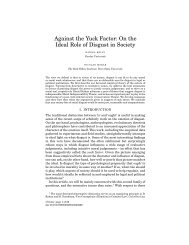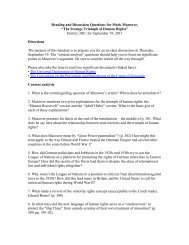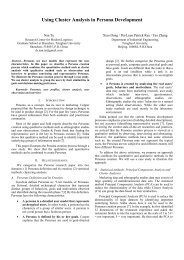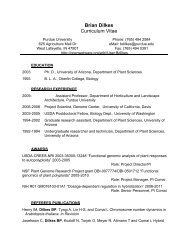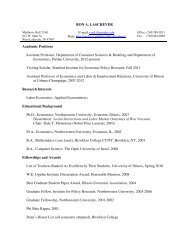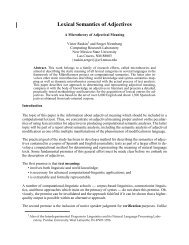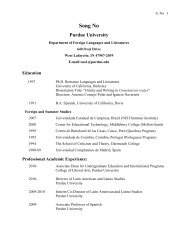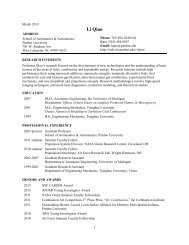The Dopamine Hypothesis of Schizophrenia: An Historical and ...
The Dopamine Hypothesis of Schizophrenia: An Historical and ...
The Dopamine Hypothesis of Schizophrenia: An Historical and ...
Create successful ePaper yourself
Turn your PDF publications into a flip-book with our unique Google optimized e-Paper software.
54 ■ PPP / Vol. 18, No. 1 / March 2011<br />
<strong>and</strong> refutations, as newer <strong>and</strong> yet more falsifiable<br />
theories were advanced.<br />
How would the DHS fare on these Popperean<br />
grounds? At its inception, the DHS was highly abstract<br />
<strong>and</strong> nonspecific, postulating that the etiology<br />
<strong>of</strong> a complex neuropsychiatric syndrome was due<br />
to hyperactivity in one neurotransmitter system.<br />
Even at the time <strong>of</strong> the articulation <strong>of</strong> the DHS,<br />
neurotransmitter systems were known to be complex<br />
<strong>and</strong> diverse, with the same neurotransmitter<br />
being used in different pathways with distinct<br />
functional roles. Control mechanisms existed at<br />
many levels, both within <strong>and</strong> between cells. Overactivity<br />
<strong>of</strong> the system could arise in many ways.<br />
As scientific underst<strong>and</strong>ing <strong>of</strong> brain functioning<br />
advanced, this problem became worse, making<br />
it more <strong>and</strong> more difficult to articulate a single,<br />
clear test <strong>of</strong> the DHS. Because <strong>of</strong> the complexity<br />
<strong>of</strong> the systems involved, the DHS was elastic in<br />
absorbing a wide range <strong>of</strong> results. <strong>The</strong> IT version<br />
<strong>of</strong> the DHS predicted that levels <strong>of</strong> DA <strong>and</strong> HVA<br />
should be increased in the brains <strong>of</strong> individuals<br />
with schizophrenia. However, the IRF version <strong>of</strong><br />
the DHS could produce a decrease in DA <strong>and</strong> HVA<br />
levels. If abnormalities were not found in global<br />
measures <strong>of</strong> DA function, then it was because the<br />
abnormalities in schizophrenia were found only<br />
in specific brain regions or pathways.<br />
In Popper’s terms, the DHS had a low degree<br />
<strong>of</strong> falsifiability. As Popper might have predicted,<br />
given its abstract formulation, if one prediction <strong>of</strong><br />
the DHS was not confirmed, another easily took<br />
its place. This nonspecificity allowed the DHS to<br />
take on the protean features that we described. In<br />
this process, the DHS has become nearly immune<br />
from falsification. Indeed, in its latest incarnation<br />
(see quote above), it seems to be more <strong>of</strong> a general<br />
framework than a specific theory.<br />
<strong>The</strong>re is a deep irony in the observation that the<br />
DHS has fared poorly at the Popperean criterion<br />
<strong>of</strong> falsifiability. <strong>The</strong> DHS emerged at a time when<br />
the nascent field <strong>of</strong> biological psychiatry argued<br />
strongly that psychoanalysis had to be ab<strong>and</strong>oned.<br />
One key argument was that psychoanalysis was<br />
not a science that was illustrated by the protean<br />
<strong>and</strong> non-falsifiable nature <strong>of</strong> key psychoanalytic<br />
theories. Such theories, they argued, could explain<br />
anything. At its inception, early biological psychiatrists<br />
would have insisted that the DHS was the<br />
antithesis <strong>of</strong> psychoanalytic theory. However, over<br />
time, the nature <strong>of</strong> DHS as a scientific hypothesis<br />
has come to resemble the psychodynamic theories<br />
that it was meant to displace.<br />
Scientists have frequently embraced the Popperean<br />
philosophy <strong>and</strong>, on deeper reflection, later<br />
became more critical <strong>of</strong> this approach (Katz 1994),<br />
in part because the actual flexibility <strong>and</strong> practice<br />
<strong>of</strong> science go beyond the Popperean model. It is to<br />
such alternative approaches we now turn.<br />
Thomas Kuhn<br />
<strong>The</strong> work <strong>of</strong> Kuhn in his classic “<strong>The</strong> Structure<br />
<strong>of</strong> Scientific Revolutions” (Kuhn 1996) can help<br />
us to underst<strong>and</strong> the endurance <strong>of</strong> the DHS. For<br />
Kuhn, Popperean falsification did not accord with<br />
scientific practice. Rather, Kuhn suggested that<br />
scientists work within broad conceptual frameworks<br />
or “paradigms.” Like most human beings,<br />
working scientists find it difficult to think outside<br />
the framework in which they “grew up.” Indeed,<br />
Kuhn suggested that scientists typically strongly<br />
resist purported falsifications <strong>of</strong> their paradigms,<br />
<strong>and</strong> irrationally retain belief in them in the face<br />
<strong>of</strong> increasing anomalies. However, at some critical<br />
point, two things can occur together, which unleashes<br />
what he termed a “scientific revolution.”<br />
First, the accumulation <strong>of</strong> anomalies in a particular<br />
research paradigm becomes unsustainable. Second,<br />
another paradigm becomes available that<br />
does a superior job at explaining these anomalies.<br />
<strong>The</strong>n the scientific field undergoes a crisis, <strong>and</strong> experiences<br />
a “conversion” as individual researchers<br />
(more <strong>of</strong>ten the young than the old) switch to the<br />
new paradigm.<br />
<strong>The</strong> DHS probably does not rise to the level <strong>of</strong><br />
a Kuhnian paradigm, which might, for example,<br />
be an appropriate description for the “biomedical<br />
model” for psychiatric disorders. Nonetheless,<br />
some <strong>of</strong> the insights <strong>of</strong> Kuhn on the historical process<br />
<strong>of</strong> science can be usefully applied to the DHS.<br />
In particular, no revolution has occurred in<br />
theories about the etiology <strong>of</strong> schizophrenia that<br />
has resulted in the wholesale ab<strong>and</strong>onment <strong>of</strong> the<br />
DHS. Why? Certainly, many empirical findings,<br />
some outlined above, are poorly explained by<br />
the DHS. However, one key ingredient has been



